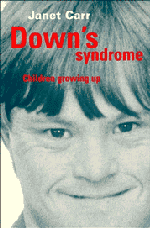Book contents
- Frontmatter
- Contents
- Acknowledgements
- 1 Down's syndrome – implications of the diagnosis
- 2 Populations and procedures
- 3 The developmental study
- 4 Self-care and independence
- 5 Behaviour and discipline
- 6 Focusing on the individual
- 7 Effect on the families
- 8 Help from services
- 9 Summary and conclusions
- References
- Index
7 - Effect on the families
Published online by Cambridge University Press: 06 July 2010
- Frontmatter
- Contents
- Acknowledgements
- 1 Down's syndrome – implications of the diagnosis
- 2 Populations and procedures
- 3 The developmental study
- 4 Self-care and independence
- 5 Behaviour and discipline
- 6 Focusing on the individual
- 7 Effect on the families
- 8 Help from services
- 9 Summary and conclusions
- References
- Index
Summary
Families are not static but constantly evolve as the members of it alter. Starting as a couple, most will then experience a profound change in the structure of their lives with the birth of their first baby; further changes take place with the arrival of other children, and with their development from babyhood to childhood to adolescence, each new stage necessitating shifts in the roles, responsibilities and concerns of each family member and, pre-eminently, in those of the parents. These stages are followed by those in which the ‘children’ become adults and move away from the family home, perhaps to start families of their own. The parents are left to some extent bereft, but they also have the chance, perhaps for the first time in 20 years or so, of consulting their own wishes and following their own preferred pursuits, rather than these being as a rule subordinated to those of the family. All these stages have their advantages and drawbacks – the child who grows beyond the stage of needing to be fed and dressed and bathed now wants a bicycle, worse still wants to ride it on the roads, with all the gut-wrenching anxiety that this entails – but they are seen as the normal progression, observed in and discussed with other families all around. When a child has a disability this normal ‘life-cycle’ (Farber 1959) is interrupted; the stages are not reached at the usual times, some may never be reached at all.
- Type
- Chapter
- Information
- Down's SyndromeChildren Growing Up, pp. 119 - 149Publisher: Cambridge University PressPrint publication year: 1995

